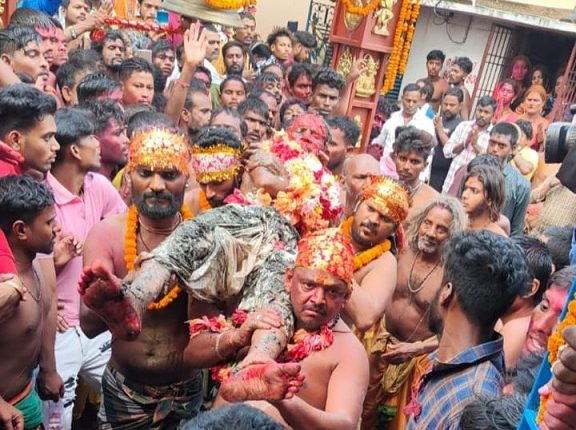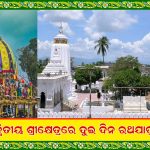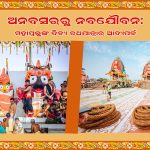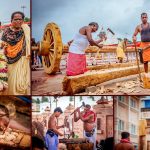The vibrant and culturally significant tradition of ‘Danda Nacha’ concluded with a final offering in Odisha’s Ganjam district, resonating with the rhythmic beats of drums, cymbals, and conch shells. Spanning over 21 days, the Danda Nacha festivities reached their crescendo on the auspicious occasion of “Maha Bishuba Sankranti.” Communities gathered in large numbers at Danda Kali temples across the district to participate in the rituals marking the culmination of the Danda Yatra. Known as ‘Meru Jatra,’ these festivities coincide with Maha Bishuba Sankranti, locally referred to as Meru Sankranti, heralding the onset of the Odia New Year.
In Berhampur, ‘Meru Jatra’ unfolded at various Danda Kali temples, drawing sizable crowds eager to witness the final offering by ‘Pata Bhoktas,’ who lead the ‘Danda Nacha’ troupes. These ‘Pata Bhoktas,’ after undergoing ritualistic baths, were led to the temples by other ‘Danduas,’ their bodies adorned with a special paste of turmeric and herbs. The culmination of their penance saw them suspended upside down above a pit of fire until three drops of blood fell from their nostrils into the flames. The Bhoktas or Danduas, who dedicate themselves to rigorous penance for three weeks as part of the ‘Danda Nacha’ troupes, concluded their period of austerity on this day. Having left the comforts of their homes to honor Goddess ‘Danda Kali,’ they would now return to their families after ‘Meru Jatra.’
Rooted in antiquity, the Danda Nacha tradition in Ganjam, observed during the Odia month of ‘Chaitra,’ holds a sacred place in the region’s heritage. Historians trace its origins to the 8th and 9th centuries, following the decline of Buddhism in Odisha and the emergence of Tantrism. The rigorous rituals and performances of the Danduas serve as acts of devotion to appease the goddess, fulfill vows, or express gratitude for blessings received. Danduas maintain strict discipline, residing near temples and adhering to a minimalistic lifestyle during the period of worship.
The dance procession, featuring rows of Danduas adorned in white, yellow, or saffron attire, is accompanied by the beating of drums and blowing of conch shells. Symbolism is woven into every aspect of the performance, with peacock plumes fanning deities carried in red boxes. While the dance is deeply rooted in tradition and ritual, participants hail from diverse backgrounds, transcending caste barriers. The meticulous adherence to tradition and the spirit of devotion infuse the Danda Nacha with cultural significance and communal reverence.
The vibrant and culturally significant tradition of ‘Danda Nacha’ concluded with a final offering in Odisha’s Ganjam district, resonating with the rhythmic beats of drums, cymbals, and conch shells. Spanning over 21 days, the Danda Nacha festivities reached their crescendo on the auspicious occasion of “Maha Bishuba Sankranti.” Communities gathered in large numbers at Danda Kali temples across the district to participate in the rituals marking the culmination of the Danda Yatra. Known as ‘Meru Jatra,’ these festivities coincide with Maha Bishuba Sankranti, locally referred to as Meru Sankranti, heralding the onset of the Odia New Year.
In Berhampur, ‘Meru Jatra’ unfolded at various Danda Kali temples, drawing sizable crowds eager to witness the final offering by ‘Pata Bhoktas,’ who lead the ‘Danda Nacha’ troupes. These ‘Pata Bhoktas,’ after undergoing ritualistic baths, were led to the temples by other ‘Danduas,’ their bodies adorned with a special paste of turmeric and herbs. The culmination of their penance saw them suspended upside down above a pit of fire until three drops of blood fell from their nostrils into the flames. The Bhoktas or Danduas, who dedicate themselves to rigorous penance for three weeks as part of the ‘Danda Nacha’ troupes, concluded their period of austerity on this day. Having left the comforts of their homes to honor Goddess ‘Danda Kali,’ they would now return to their families after ‘Meru Jatra.’
Rooted in antiquity, the Danda Nacha tradition in Ganjam, observed during the Odia month of ‘Chaitra,’ holds a sacred place in the region’s heritage. Historians trace its origins to the 8th and 9th centuries, following the decline of Buddhism in Odisha and the emergence of Tantrism. The rigorous rituals and performances of the Danduas serve as acts of devotion to appease the goddess, fulfill vows, or express gratitude for blessings received. Danduas maintain strict discipline, residing near temples and adhering to a minimalistic lifestyle during the period of worship.
The dance procession, featuring rows of Danduas adorned in white, yellow, or saffron attire, is accompanied by the beating of drums and blowing of conch shells. Symbolism is woven into every aspect of the performance, with peacock plumes fanning deities carried in red boxes. While the dance is deeply rooted in tradition and ritual, participants hail from diverse backgrounds, transcending caste barriers. The meticulous adherence to tradition and the spirit of devotion infuse the Danda Nacha with cultural significance and communal reverence.





